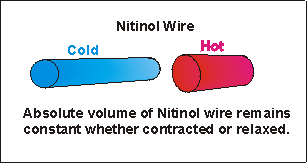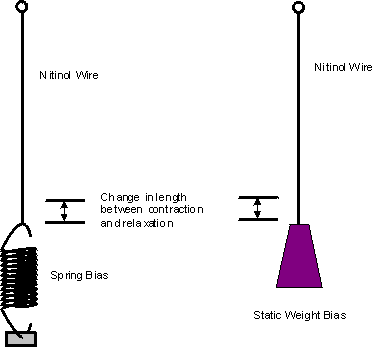 Figure 4 Flexinol Wire Volume
Figure 4 Flexinol Wire Volume
Nitinol belongs to a class of materials called Shaped Memory Alloys (SMA). SMA's have interesting mechanical properties: shape memory and superelasticity. Shape memeory allows the nitinol material to be deformed, then upon heating above it "transitition temperature" will recover to it original "undeformed" shape.
Flexinol wire for example, has been trained to contract when heated, which is the opposite of what standard metals do when heated which is expand. Not only does this nitinol alloy contract, but does so with a 100 times greater thermal movement (expansion-contraction) than standard metals.
We will work with either 6-mil (.006 inch diameter) or 15-mil (.015 inch diameter) Flexinol wire. During the course of this article we will make reference to Nitinol wire. I prefer to use the general term nitinol. In essence whenever nitinol is referenced we will taking about Flexinol unless otherwise stated. The 6-mil Flexinol wire has a rated contractive force of 11 ounces; the 15-mil Flexinol wire has a rated contractive force of 63 ounces (4 lbs).
The wire may be contracted up to 8%-10% of its length. However, for longer lifetime (greater than 1,000,000 cycles), you should restrict the contraction to only 5-6% of its length.
While the length of the wire may change, the absolute volume of nitinol material of the wire remains constant, see figure 4.

Contraction and relaxation depend solely on the temperature of the nitinol alloy wire. Any method of heating and cooling the wire may be used. Nitinol wire has a high electrical resistance, approximately 1.25 ohms resistance per inch for the 6-mil wire. The resistance of the wire to the electric current quickly generates sufficient heat (ohmic heating) to bring the wire through its transition temperature. So many times an electric current is passed through nitinol wire to heat the wire electrically. When the material is allowed to cool, the wire can easily be stretched back it its original length.
Nitinol wire usually has a counter-force applied to it in the opposite direction of its contraction. The counter force resets, or stretches the wire back to its original length when in the low temperature phase. This is called the bias force. If the nitinol wire is brought to its transition temperature without a bias force it will contract, however, when it cools it will not return to its original length.
Consequently, without a bias force, when the wire is reheated no further contraction will take place. In most applications a bias force is applied to the wire constantly. Figure 2 illustrates two methods of applying a bias force, a spring and a static weight. The speed and strength of the wire contraction depend upon how fast and how high the temperature of the wire is increased. For example, 400 mA of electrical current through the 6-mil nitinol wire will produce a maximum pull of 11 ounces and full contraction in one second. Reaction time can be faster, in the millisecond range. To achieve this high current short duration pulses are used. When doing this consideration must be given to the mass and speed of the material to move. The faster you move a given mass the greater the inertia that must be overcome. If the inertia becomes greater than 6 lbs. for the 6-mil wire, it will snap. Full contractive force is produced at the beginning of a cycle. In contrast to standard electrical solenoids that develop full strength near the end of their cycle.

